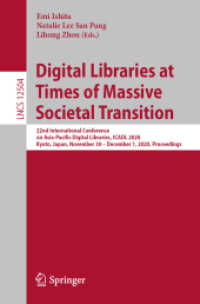Full Description
This book describes and discusses the convergence of library and technology support in higher education. Over the past 15 years, a number of institutions have pursued merging library and technology services into a single information support organization. These mergers have taken different forms, but all seek to redefine information support in a 21st century model that promotes the interdisciplinary use of information. The coming years will see significant change affect libraries with the continuing disruption of the Internet and digitally-based services. Coupled with economic pressures, libraries and technology organizations will increasingly be forced to look closely at long-held assumptions of how their teams are organized and how work is divided and shared. Convergence of Libraries and Technology Organizations provides useful and practical guidance on converged information organizations as an effective response to change in the information profession.
Contents
List of figuresAbout the authorAcknowledgementsChapter 1: Context for convergence: Arriving at the deltaAbstract:A new economy with information as currencyA glance over our shoulders: evolution of an information economyEvolution of a service economyEvolution of converged information service organizationsRocks all aroundThe old rules don't applyRules of the riverThe sweet spotChapter 2: Assessing possibilities for convergence: Reading the riverAbstract:Why converge?Motivating factors for convergenceSummary of motivationsBenefits of convergenceChallenges aheadThe organizational context of information supportKey considerationsChapter 3: Professional culture and politics: Conflict at the helmAbstract:Core valuesValues of library professionalsValues of technology professionalsConnections: common valuesDifferentiating contextsKey considerationsChapter 4: Staffing for convergence: Crew selectionAbstract:The importance of leadershipThe staffWatching for the silver liningStaff duties in the converged organizationStaffing vacanciesHuman resource considerationsDon't forget the studentsKey considerationsChapter 5: Specialization versus generalization: Crew assignmentsAbstract:PolymathsGeneralization and specializationKey considerationsChapter 6: Organizational design in converged organizations: Streamlining the vesselAbstract:Alignment within the institutionPhysical representations of convergenceVirtual representations of convergenceTeam structuresResource allocation and applicationReducing redundancyStrategic planningMarketing and the webDeveloping an organizational designKey considerationsChapter 7: The process of converging: Riding the riverAbstract:LeadershipA case for convergenceHallmarks of design: visionHallmarks of design: collaborationHallmarks of design: transparencyHallmarks of design: processEvolution vs. revolutionOn the ground: ten keys for deploymentKey considerationsChapter 8: Future evolutions of information service organizations: Around the bend in the riverAbstract:Print collectionsData collectionsThe research processCyberinfrastructureThe cloudMultimediaMetadataUser interfacesThe future is convergedReferences and further readingIndex








